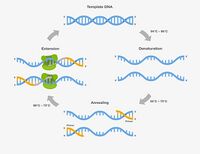BME100 f2018:Group10 T1030 L4
From OpenWetWare
Jump to navigationJump to search
PCR Reaction Sample List
| Home People Lab Write-Up 1 | Lab Write-Up 2 | Lab Write-Up 3 Lab Write-Up 4 | Lab Write-Up 5 | Lab Write-Up 6 Course Logistics For Instructors Photos Wiki Editing Help | ||||||
|
OUR TEAM
LAB 4 WRITE-UPProtocolMaterials
| ||||||
| Tube Label | PCR Reaction Sample | Patient ID |
| G10 + | Positive control | none |
| G10 - | Negative control | none |
| G10 1-1 | Patient 1, replicate 1 | 28319 |
| G10 1-2 | Patient 1, replicate 2 | 28319 |
| G10 1-3 | Patient 1, replicate 3 | 28319 |
| G10 2-1 | Patient 2, replicate 1 | 81362 |
| G10 2-2 | Patient 2, replicate 2 | 81362 |
| G10 2-3 | Patient 2, replicate 3 | 81362 |
DNA Sample Set-up Procedure
- 1) Create Wiki web page for group
- 2) Gather PPE (including lab coat and goggles)
- 3) Make PCR reaction mix: Gather 8 tubes and put 50 μL of mix ; Inside mix there is Taq DNA polymerase, MgCl2, dNTP's
- 4) The DNA/primer mix is within the 8 tubes with 50 μL of mix in each containing different template DNA and the same forward and reverse primer.
- 5) Obtain a strip of empty PCR tubes
- 6) Gather disposable pipette tips (ONLY use one time)
- 7) Have a cup for discarded/contaminated tips
- 8) Get the micropipettor
- 9) From there, OpenPCR machine that is shared by two groups
OpenPCR program
1) Heated Lid: 100°C
2) Initial Step: 95°C for 2 minutes
3) Number of Cycles: 25
Denature at 95°C for 30 seconds, Anneal at 57°C for 30 seconds, and extend at 72°C for 30 seconds
4) Final Step: 72°C for 2 minutes
5) Final Hold: 4°C
Summary of thermal cycling program:
 * This process occurs through heating and cooling the tubes carrying PCR mixture.
* This process occurs through heating and cooling the tubes carrying PCR mixture.
Research and Development
PCR - The Underlying Technology
Components of a PCR Reaction
There are multiple components of the PCR reaction. The first and perhaps the most important piece is the template DNA. The template DNA is a two stranded, double helix of deoxyribonucleic acid that holds the genetic code for organisms. DNA is also known for cell division, replication, and has genes coded for proteins. In order for the polymerase to bind to the template DNA strand, primers are needed. Primers are short pieces of DNA that bind to the template strand of DNA. There are two primers involved in the PCR process. Each primer is specifically created to match the DNA segment that will be copied. The first primer attaches to top portion of the template strand. The other primer attaches to the bottom strand at the opposite end of the first primer. Taq polymerase comes from Thermus aquaticus cell pol gene. It is an enzyme that puts together new strands of DNA by combining individual nucleotides based off of the complementary bases. Finally, deoxyribonucleotides or dNTP’s are made up of three different parts: a nitrogenous base, a deoxyribose suger, and finally a phosphate group. dNTP’s are created through the reduction of ribose that is contained inside nucleotides. Then, ADP and GDP are used as substrates.
Steps of Thermal Cycling
Once the extracted DNA, both primers, nucleotides and DNA polymerase are mixed into one solution, the first step of the PCR process is to heat up the solution to to 95 °C for two minutes. By heating up the solution to almost boiling, this causes the DNA double helix to separate into two individual strands. This process is known as denaturing where the DNA is melted/heated to create two separate template strands of DNA by breaking apart the hydrogen bonds. Next, is the process of annealing where the temperature is lowered to 57℃ for approximately 30 seconds. Annealing allows the two primers to bind to the separate strands before they are able to rejoin. The next step is extension where the temperature is raised to 72℃ for 30 seconds. In the extension step, the Taq polymerase enzyme creates the new strand of DNA complementary to the template strand. The final step where the solution is held at 72℃ for two minutes so that the polymerases finish processing to be stored. At the final hold which is held at 4℃ stores the new products and polymerases in a refrigerator-like device that ensures against degradation.
Matching Base Pairs
Adenine (A) pairs with Thymine (T) and Cytosine (C) pairs with Guanine (G). So in short A pairs with T, G pairs with C and vice versa.
When does base-pairing occur
There are two steps in the PCR process in which base-pairing occurs. The first step where base pairing occurs is the annealing step, where the primers come and bind to their complementary bases on the template strands of DNA. The second step is extending; in this step, the Taq polymerase adds the complementary nucleotide bases to create new replicate copies of the DNA strands.
SNP Information & Primer Design
Background: About the Disease SNP
SNP stands for single nucleotide polymorphism, and it is a found in a sequence of DNA. SNPs are one of the most common genetic variation types and can be found in Homo Sapiens (people).They occur in approximately every 300 nucleotides, which results in about 10 million SNPs in the entire genome for humans. It is located in the chromosome 12:40315266. The Clinical significance is under uncertain. This SNP linked to Parkinson’s Disease, Diabetes, heart disease, and others.
Primer Design and Testing
The non-disease primers were run through the primer test and it resulted in a 220 bp sequence of DNA from the 12:40315266 chromosome. We also found that the primer melting temperatures for both strains were at 44.7c for the forward strain and at 49.2c for the reverse strain. However, when we ran the disease primers, they turned out to have no matches or results which was fine considering that the primers were expected to have no matches. Below are screen captures of the Non-disease primer and disease primer results when tested.





